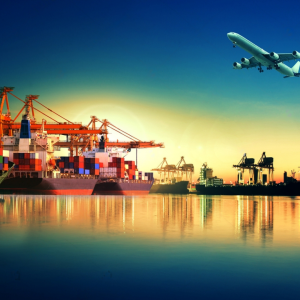The choice between air freight and ocean freight depends on the delivery speed, cost, and the size and weight of the product.
What impacts Ocean freight rates and Air freight rates?

air and ocean freight transport solution
Trade tensions between major economies like China, the United States, and Europe can change freight rates. This happens when trade restrictions, sanctions, or changes in trade routes to higher ocean and air rates. Global inflation impacts transportation operations, including fuel costs, demand, currency fluctuations, Digitization processes and optimization of routes, and the increasing demand for E-commerce. These factors impact ocean and air freight rates.
Identifying the months with higher demand in peak trade season is important, as this often leads to increased prices and limited space in ships and airlines. By scheduling ocean shipments in advance, reducing costs associated with high-demand periods may be possible. Factors like port congestion and adverse weather conditions can further affect freight services and costs. Therefore, planning is essential to optimize shipping service expenses and avoid significant price surges.
Strategies for saving on shipping costs in uncertainty and rate fluctuations.

Ship a full FCL container or less than an LCL container
Please note that shipping options should be planned. This way, you will avoid rate increases and pay higher rates associated with express or air shipping. Consider that if you do ocean freight shipping, it may take longer and is more economical. In addition, you can ship a full FCL container or less than an LCL container.
In this mode of transportation, larger shipments can occupy a full container using the FCL (Full Container Load) option. Smaller shipments can share a container with other customers using the LCL (Less than Container Load) option. These options suit different logistical needs. In the case of FCL, it is advisable to make the most of the container’s capacity, as loading it efficiently can significantly reduce the cost per unit transported. If you do not have enough goods to fill an entire container, the LCL option allows you to consolidate shipments with products from other companies, allowing you to share the transportation costs and perform proper freight transportation.
Airfreight can be more expensive, but smaller shipments can be more cost-effective in transit time as the minimum terminal fees at the destination are usually lower. In addition, flights to most countries depart daily, offering greater flexibility to ship goods to any destination. Airfreight is also advantageous when shipping to countries that are landlocked or not easily accessible by sea. On the other hand, ocean freight is more suitable for large shipments, especially if you can fill an entire container and take advantage of the FCL (Full Container Load) option.

Different shipping options
This will allow you to secure more stable rates and avoid sharp price fluctuations and quotes from several transportation providers before closing a deal. Sometimes minor differences in routes or transit times can offer significant savings.
Negotiating strategically with logistics providers is essential. Instead of managing individual shipments, consider establishing long-term contracts with shipping lines or freight forwarders. This will allow you to guarantee more stable rates and reduce the impact of price fluctuations. In addition, online rate comparison platforms should be used to evaluate different shipping options, both air and ocean. Always make quotations with several suppliers before making a decision. Slight differences in routes or transit times can generate significant savings.
Remember that the key is to adapt the shipping strategy according to the needs of your cargo, available routes, and current rates, always looking for the right balance between cost and efficiency.



Leave A Comment
You must be logged in to post a comment.